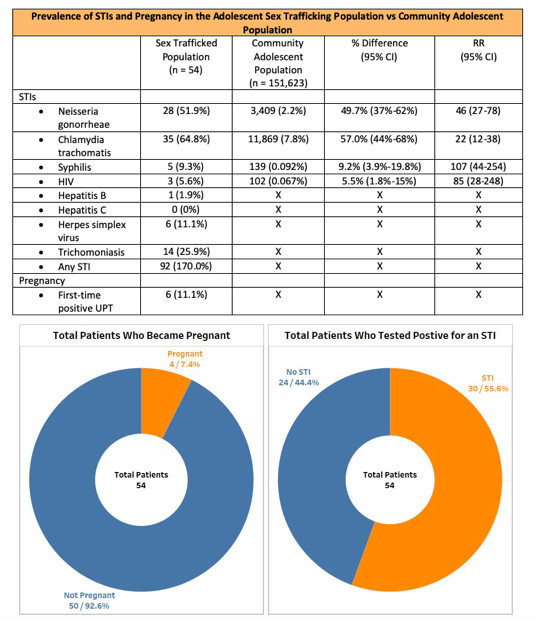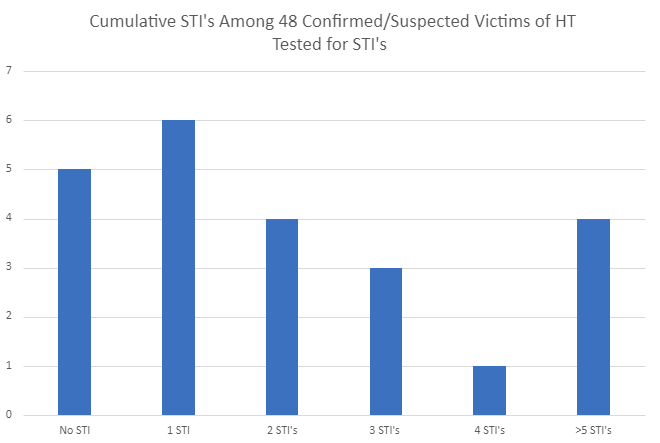Child Abuse & Neglect
Child Abuse & Neglect 2
607 - Incidence of Sexually Transmitted Infections and Pregnancy Among Adolescent Sex Trafficking Victims
Publication Number: 607.104
- LE
Lauren Ehrhardt-Humbert, MS (she/her/hers)
Medical Student
Wake Forest School of Medicine of Wake Forest Baptist Medical Center
Charlotte, North Carolina, United States .jpeg.jpg)
Whitney Ficker, MD
Pediatric Emergency Medicine Fellow
Carolinas Medical Center
Charlotte, North Carolina, United States
Presenting Author(s)
Co-Author(s)
Background:
Human trafficking is a human rights and public health crisis. There is a lack of data regarding the prevalence of sexually transmitted infections (STIs) and pregnancy among adolescents experiencing sex trafficking.
Objective:
The purpose of this study was to determine the reproductive health outcomes among adolescents evaluated for potential sex trafficking at an urban, tertiary children’s hospital.
Design/Methods:
This was a retrospective, cross-sectional study of adolescents ages 11-21 in the Atrium Health Human Trafficking Response Team Database from March 2019 to March 2022. Suspected or confirmed sex trafficking victims who were identified using evidence-based tools (West Coast CSE-IT, Modified TVIT) were included in the study. Data was collected using standardized methods. Inter-observer agreement was 100% on data elements abstracted. Demographic information, pre-existing diagnoses and presenting medical complaints, and type of trafficking were recorded. Rates of Neisseria gonorrheae (GC), Chlamydia trachomatis (CT), syphilis, HIV, and pregnancy were determined. Using the Fisher exact test, the prevalence of STIs among adolescent sex trafficking patients was compared to the prevalence of STIs among adolescents in the community using local county health department data.
Results:
Between March 2019 and March 2022, 54 confirmed or suspected adolescent sex trafficking victims were identified by the Human Trafficking Response Team. Among these adolescent patients, 93% were female, and average age was 16 years. 56% of patients were African American, and 30% were white. 78% had a history of abuse. Exploitation included confirmed sex trafficking (56%; 95% CI 41-69%), confirmed familial sex trafficking (6%; 95% CI 1-15%), sex/labor trafficking (4%; 95% CI 0.4-13%), trafficking of a parent (2%; 95% CI 0-10%), and suspected trafficking (33%; 95% CI 8-29%). 30 (56%; 95% CI 41%-69%) of the sex trafficking patients tested positive for an STI. Total number of STIs, compared to county health data, are as follows: 28 (52%) for GC vs 2% (RR 46; 95% CI 27-78), 35 (65%) for CT vs 8% (RR 22; 95% CI 12-38), 5 (9%) for syphilis vs 0.09% (RR 107; 95% CI 44-254), and 3 (6%) for HIV vs 0.07% (RR 85; 95% CI 28-248). Figure 2 details cumulative STIs across 60 health care encounters with an indication for STI testing. 4 (7%; 95% CI 2%-18%) of the trafficking patients were found to be pregnant with some having multiple pregnancies.
Conclusion(s):
Adolescent sex trafficking patients presenting to an urban, tertiary children’s hospital have a significantly higher rate of STIs than the community adolescent population.

.png)

